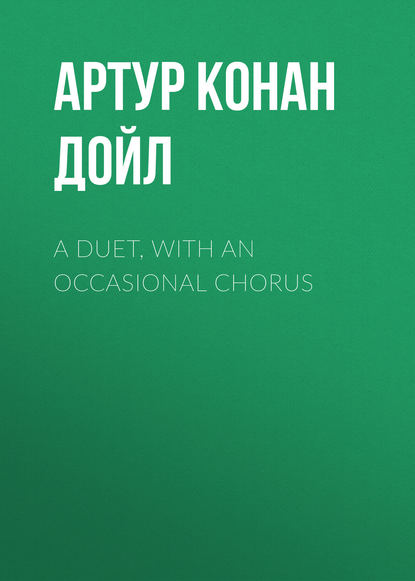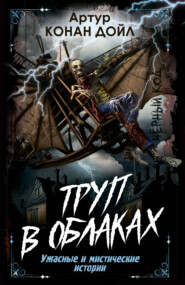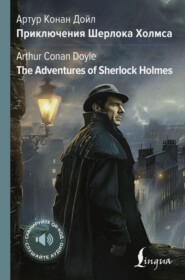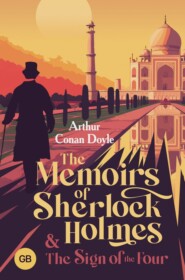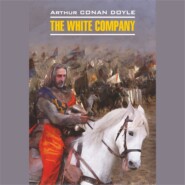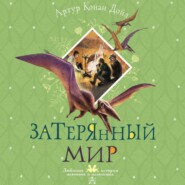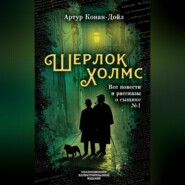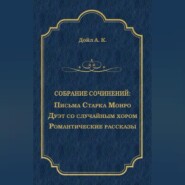По всем вопросам обращайтесь на: info@litportal.ru
(©) 2003-2024.
✖
A Duet, with an Occasional Chorus
Настройки чтения
Размер шрифта
Высота строк
Поля
‘I believe he is more read than any poet in England.’
‘Who is that standing figure?’
‘It is Dryden. What a clever face, and what a modern type. Here is Walter Scott beside the door. How kindly and humorous his expression was! And see how high his head was from the ear to the crown. It was a great brain. There is Burns, the other famous Scot. Don’t you think there is a resemblance between the faces? And here are Dickens, and Thackeray, and Macaulay. I wonder whether, when Macaulay was writing his essays, he had a premonition that he would be buried in Westminster Abbey. He is continually alluding to the Abbey and its graves. I always think that we have a vague intuition as to what will occur to us in life.’
‘We can guess what is probable.’
‘It amounts to more than that. I had an intuition that I should marry you from the first day that I saw you, and yet it did not seem probable. But deep down in my soul I knew that I should marry you.’
‘I knew that I should marry you, Frank, or else that I should never marry at all.’
‘There now! We both had it. Well, that is really wonderful!’
They stood among the memorials of all those great people, marvelling at the mysteries of their own small lives. A voice at their elbows brought them back to the present.
‘This way, if you please, for the kings,’ said the voice. ‘They are now starting for the kings.’
‘They’ proved to be a curiously mixed little group of people who were waiting at the entrance through the enclosure for the arrival of the official guide. There were a tall red-bearded man with a very Scotch accent and a small gentle wife, also an American father with his two bright and enthusiastic daughters, a petty-officer of the navy in his uniform, two young men whose attention was cruelly distracted from the monuments by the American girls, and a dozen other travellers of various sexes and ages. Just as Maude and Frank joined them the guide, a young fresh-faced fellow, came striding up, and they passed through the opening into the royal burying-ground.
‘This way, ladies and gentlemen,’ cried the hurrying guide, and they all clattered over the stone pavement. He stopped beside a tomb upon which a lady with a sad worn face was lying. ‘Mary, Queen of Scots,’ said he, ‘the greatest beauty of her day. This monument was erected by her son, James the First.’
‘Isn’t she just perfectly sweet?’ said one of the American girls.
‘Well, I don’t know. I expected more of her than that,’ the other answered.
‘I reckon,’ remarked the father, ‘that if any one went through as much as that lady did, it would not tend to improve her beauty. Now what age might the lady be, sir?’
‘Forty-four years of age at the time of her execution,’ said the guide.
‘Ah weel, she’s young for her years,’ muttered the Scotchman, and the party moved on. Frank and Maude lingered to have a further look at the unfortunate princess, the bright French butterfly, who wandered from the light and warmth into that grim country, a land of blood and of psalms.
‘She was as hard as nails under all her gentle grace,’ said Frank. ‘She rode eighty miles and hardly drew rein after the battle of Langside.’
‘She looks as if she were tired, poor dear!’ said Maude; ‘I don’t think that she was sorry to be at rest.’
The guide was narrating the names of the owners of the tombs at the further end of the chapel. ‘Queen Anne is here, and Mary the wife of William the Third is beside her. And here is William himself. The king was very short and the queen very tall, so in the sculptures the king is depicted standing upon a stool so as to bring their heads level. In the vaults beyond there are thirty-eight Stuarts.’
Thirty-eight Stuarts! Princes, bishops, generals, once the salt of the earth, the mightiest of men, and now lumped carelessly together as thirty-eight Stuarts. So Death the Republican and Time the Radical can drag down the highest from his throne.
They had followed the guide into another small chapel, which bore the name of Henry VII. upon the door. Surely they were great builders and great designers in those days! Had stone been as pliable as wax it could not have been twisted and curved into more exquisite spirals and curls, so light, so delicate, so beautiful, twining and turning along the walls, and drooping from the ceiling. Never did the hand of man construct anything more elaborately ornate, nor the brain of man think out a design more absolutely harmonious and lovely. In the centre, with all the pomp of mediæval heraldry, starred and spangled with the Tudor badges, the two bronze figures of Henry and his wife lay side by side upon their tomb. The guide read out the quaint directions in the king’s will, by which they were to be buried ‘with some respect to their Royal dignity, but avoiding damnable pomp and outrageous superfluities!’ There was, as Frank remarked, a fine touch of the hot Tudor blood in the adjectives. One could guess where Henry the Eighth got his masterful temper. Yet it was an ascetic and priest-like face which looked upwards from the tomb.
They passed the rifled tombs of Cromwell, Blake, and Ireton – the despicable revenge of the men who did not dare to face them in the field, – and they marked the grave of James the First, who erected no monument to himself, and so justified in death the reputation for philosophy which he had aimed at in his life. Then they inspected the great tomb of Villiers, Duke of Buckingham, as surprising and as magnificent as his history, cast a glance at the covering of plucky little George the Second, the last English king to lead his own army into battle, and so onwards to see the corner of the Innocents, where rest the slender bones of the poor children murdered in the Tower.
But now the guide had collected his little flock around him again, with the air of one who has something which is not to be missed. ‘You will stand upon the step to see the profile,’ said he, as he indicated a female figure upon a tomb. ‘It is the great Queen Elizabeth.’
It was a profile and a face worth seeing – the face of a queen who was worthy of her Shakespeares upon the land and her Drakes upon the sea. Had the Spanish king seen her, he would have understood that she was not safe to attack – this grim old lady with the eagle nose and the iron lips. You could understand her grip upon her cash-box, you could explain her harshness to her lovers, you could realise the confidence of her people, you could read it all in that wonderful face.
‘She’s splendid,’ said Frank.
‘She’s terrible,’ said Maude.
‘Did I understand you to say, sir,’ asked the American, ‘that it was this lady who beheaded the other lady, Queen of Scotland, whom we saw ’way back in the other compartment?’
‘Yes, sir, she did.’
‘Well, I guess if there was any beheading to be done, this was the lady to see that it was put through with promptness and despatch. Not a married lady, I gather?’
‘No, sir.’
‘And a fortunate thing for somebody. That woman’s husband would have a mean time of it, sir, in my opinion.’
‘Hush, poppa,’ said the two daughters, and the procession moved on. They were entering the inner chapel of all, the oldest and the holiest, in which, amid the ancient Plantagenet kings, there lies that one old Saxon monarch, confessor and saint, the holy Edward, round whose honoured body the whole of this great shrine has gradually risen. A singular erection once covered with mosaic work, but now bare and gaunt, stood in the centre.
‘The body of Edward the Confessor is in a case up at the top,’ said the guide. ‘This hollow place below was filled with precious relics, and the pilgrims used to kneel in these niches, which are just large enough to hold a man upon his knees. The mosaic work has been picked out by the pilgrims.’
‘What is the date of the shrine?’ asked Frank.
‘About 1250, sir. The early kings were all buried as near to it as they could get, for it was their belief in those days that the devil might carry off the body, and so the nearer they got to the shrine the safer they felt. Henry the Fifth, who won the battle of Agincourt, is there. Those are the actual helmet, shield, and saddle which he used in the battle upon the crossbeam yonder. That king with the grave face and the beard is Edward the Third, the father of the Black Prince. The Black Prince never lived to ascend the throne, but he was the father of the unfortunate Richard the Second, who lies here – this clean-shaven king with the sharp features. Now, ladies and gentlemen, if you will turn this way, I will show you one of the most remarkable objects in the Abbey.’
The object in question proved to be nothing more singular than a square block of stone placed under an old chair. And yet as the guide continued to speak, they felt that he had justified his words.
‘This is the sacred stone of Scone upon which the kings of Scotland have been crowned from time immemorial. When Edward the First overran Scotland 600 years ago, he had it brought here, and since then every monarch of England has also sat upon it when crowned.’
‘The present Queen?’ asked some one.
‘Yes, she also. The legend was that it was the stone upon which Jacob rested his head when he dreamed, but the geologists have proved that it is red sandstone of Scotland.’
‘Then I understand, sir, that this other throne is the Scottish throne,’ said the American gentleman.
‘No, sir, the Scottish throne and the English throne are the same throne. But at the time of William and Mary it was necessary to crown her as well as him, and so a second throne was needed. But that of course was modern.’
‘Only a couple of hundred years ago. I wonder they let it in. But I guess they might have taken better care of it. Some one has carved his name upon it.’
‘A Westminster boy bet his schoolfellows that he would sleep among the tombs, and to prove that he had done it, he carved his name upon the throne.’
‘You don’t say!’ cried the American. ‘Well, I guess that boy ended pretty high up.’
‘As high as the gallows, perhaps,’ said Frank, and every one tittered, but the guide hurried on with a grave face, for the dignity of the Abbey was in his keeping.
‘This tomb is that of Queen Eleanor,’ said he.
Frank twitched Maude by the sleeve. ‘Eleanor of Charing Cross,’ said he. ‘See how one little bit of knowledge links on with another.’
‘And here is the tomb of her husband, Edward the First. It was he who brought the stone from Scone. At the time of his death the conquest of Scotland was nearly done, and he gave orders that his burial should be merely temporary until Scotland was thoroughly subdued. He is still, as you perceive, in his temporary tomb.’
The big Scotchman laughed loudly and derisively. All the others looked sadly at him with the pitying gaze which the English use towards the more excitable races when their emotion gets the better of them. A stream from a garden hose could not have damped him more.
‘They opened the grave last century,’ said the guide. ‘Inside was an inscription, which said, “Here lies the hammer of the Scots.” He was a fine man, six feet two inches from crown to sole.’





